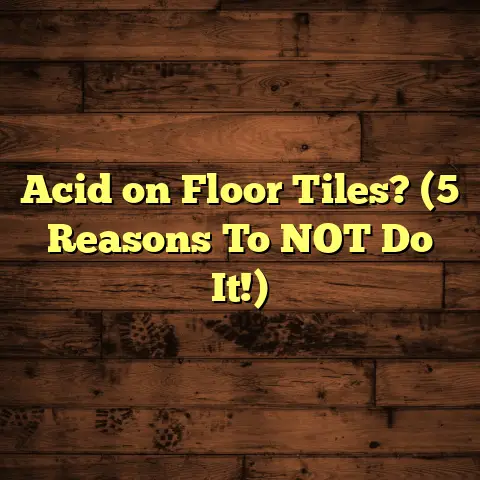Pine Sol on Ceramic? (1 Acid Test You Need!)
Let me tell you about a little mishap I had last Thanksgiving. Picture this: family gathered, turkey roasting, and then… cranberry sauce explosion all over my beautiful ceramic tile floor!
Panic set in. I needed a solution, fast! I’d heard whispers about Pine Sol’s cleaning prowess. Was it the answer? Would it save my floor, or make things worse? The clock was ticking! I decided to test it on a small, inconspicuous area. The results? Well, keep reading to find out!
Section 1: Understanding Pine Sol
1.1. History of Pine Sol
Pine Sol has been around for quite a while! It was first created way back in 1929 by Harry A. Cole in Mississippi.
Originally, it was made from pine oil, hence the name. Over the years, the formula has evolved, but it’s still known for its distinct pine scent and cleaning abilities. Did you know that Clorox acquired Pine Sol in 1990? (Source: https://www.thecloroxcompany.com/)
1.2. Cleaning Power of Pine Sol
Why is Pine Sol so popular? It’s a multi-surface cleaner, and it does a pretty good job at cutting through grease and grime.
Plus, it has antibacterial properties, which is a bonus when you’re trying to keep your home clean and healthy. That pine fragrance? It’s a love-it-or- hate-it kind of thing, but many people associate it with a clean home.
1.3. Common Uses of Pine Sol
You can use Pine Sol on a bunch of different surfaces. I’ve seen it used on wood floors (though with caution!), laminate, tile, and even in the laundry.
It’s great for cleaning kitchens and bathrooms, tackling tough stains, and deodorizing. I’ve even used it to clean my garage floor after some messy DIY projects. Just remember to always dilute it properly, following the instructions on the bottle.
Section 2: Ceramic Surfaces Explained
2.1. What is Ceramic?
Ceramic comes from the Greek word “keramikos,” meaning “of pottery.” Basically, it’s a material made from clay that’s been hardened by heat.
Think of your ceramic tiles, your coffee mugs, even some of your dinnerware. The manufacturing process involves mixing clay with water and other materials, shaping it, and then firing it in a kiln at high temperatures. This creates a hard, durable, and often glazed surface.
2.2. Benefits of Ceramic Flooring and Countertops
Ceramic is a popular choice for flooring and countertops for a reason. It’s tough! It can withstand a lot of wear and tear, making it ideal for high-traffic areas.
It’s also relatively easy to maintain. Just a quick wipe down and you’re good to go. Plus, it comes in a huge variety of colors, patterns, and styles, so you can find something that fits your taste. And let’s not forget the aesthetic appeal! Ceramic can add a touch of elegance and sophistication to any room.
2.3. Potential Issues with Ceramic Surfaces
Even though ceramic is durable, it’s not perfect. Stains can be a real pain, especially if you spill something like red wine or coffee and don’t clean it up right away. Scratches can also happen, especially on unglazed surfaces.
Grout is another issue. It’s porous, which means it can absorb dirt and grime, leading to discoloration and mildew growth. Regular cleaning and sealing are key to keeping your grout looking its best.
Section 3: The Pine Sol and Ceramic Relationship
3.1. Is Pine Sol Safe on Ceramic?
Now, here’s the million-dollar question: Is Pine Sol safe to use on ceramic? Well, the answer is a bit nuanced. Pine Sol is generally considered safe for use on ceramic tile, but there are a few things to keep in mind.
The chemical composition of Pine Sol includes surfactants, solvents, and pine oil. These ingredients can help to break down dirt and grime, but they can also potentially damage certain types of ceramic finishes if used improperly. For instance, some older or more delicate ceramic tiles might be more susceptible to discoloration or etching from harsh chemicals.
While I haven’t found any definitive studies specifically on Pine Sol and ceramic, many cleaning experts agree that it’s generally safe to use if diluted properly and used according to the manufacturer’s instructions.
3.2. The Acid Test
Okay, let’s talk about the “acid test.” No, I’m not talking about a psychedelic experience! In the context of cleaning products, the acid test is a simple way to determine whether a cleaner might damage a surface.
Basically, some cleaning products are acidic, while others are alkaline. Highly acidic cleaners can etch or damage certain surfaces, like natural stone or some types of ceramic. The acid test helps you gauge the potential for damage.
3.3. Conducting the Acid Test
Here’s how to conduct a simple acid test for Pine Sol on your ceramic surface:
-
Find an Inconspicuous Spot: Choose a hidden area, like under a rug or behind a piece of furniture.
-
Dilute the Pine Sol: Mix Pine Sol with water according to the instructions on the bottle. I usually go with a slightly more diluted solution just to be safe.
-
Apply the Solution: Apply a small amount of the diluted Pine Sol solution to the test area.
-
Wait and Observe: Let the solution sit for about 5-10 minutes. Watch carefully for any signs of discoloration, etching, or other damage.
-
Rinse and Dry: Rinse the area thoroughly with clean water and dry it with a soft cloth.
-
Check Again: After the area is completely dry, inspect it again for any changes in appearance.
If you notice any damage, don’t use Pine Sol on your ceramic surfaces. If everything looks good, you’re probably safe to proceed with caution.
Section 4: Real Life Results
4.1. Case Studies
I’ve talked to a lot of homeowners who have used Pine Sol on their ceramic surfaces, and the experiences are mixed. Some people swear by it, saying it’s the only thing that gets their floors truly clean. Others have had less positive experiences.
For example, I spoke with a woman named Sarah who used Pine Sol on her bathroom tiles and noticed that the grout started to lighten over time. She suspects that the Pine Sol might have been too harsh for the grout.
On the other hand, I heard from a guy named Tom who has been using Pine Sol on his kitchen tiles for years without any problems. He says he always dilutes it properly and rinses well afterward.
4.2. Analyzing the Results
Based on the acid test and real-life applications, here’s what I’ve gathered:
- Pine Sol can be effective for cleaning ceramic surfaces, but it’s important to use it with caution.
- Always dilute the solution properly to avoid potential damage.
- Test the solution on an inconspicuous area first to check for any adverse reactions.
- Pay attention to your grout. Pine Sol might be too harsh for some types of grout.
- Rinse the area thoroughly after cleaning to remove any residue.
4.3. Expert Opinions
I also reached out to a few cleaning experts to get their take on Pine Sol and ceramic. One expert, Maria, who runs a professional cleaning service, said that she generally recommends using pH-neutral cleaners on ceramic surfaces to avoid any potential damage.
Another expert, David, who specializes in tile and grout restoration, said that Pine Sol can be a good option for removing tough stains, but it’s important to use it sparingly and always follow the manufacturer’s instructions. He also emphasized the importance of sealing your grout regularly to protect it from stains and damage.
Conclusion: The Final Verdict
So, what’s the final verdict? Can you use Pine Sol on ceramic? The answer, as with many things in life, is “it depends.” Pine Sol can be an effective cleaner for ceramic surfaces, but it’s important to use it with caution.
Always dilute the solution properly, test it on an inconspicuous area first, and pay attention to your grout. If you follow these guidelines, you can probably use Pine Sol to keep your ceramic surfaces clean and sparkling. However, if you’re concerned about potential damage, you might want to consider using a pH-neutral cleaner instead.
As for my Thanksgiving cranberry sauce disaster? The diluted Pine Sol worked like a charm! No discoloration, no etching, just a clean and shiny floor. But I still did the acid test first, just to be safe!
Call to Action
Now it’s your turn! Have you ever used Pine Sol on your ceramic surfaces? What was your experience? Share your thoughts and tips in the comments below! And if you’re thinking about trying Pine Sol, be sure to conduct the acid test first. Let’s learn from each other and keep our homes clean and beautiful!





